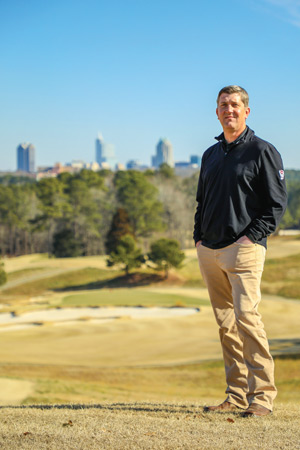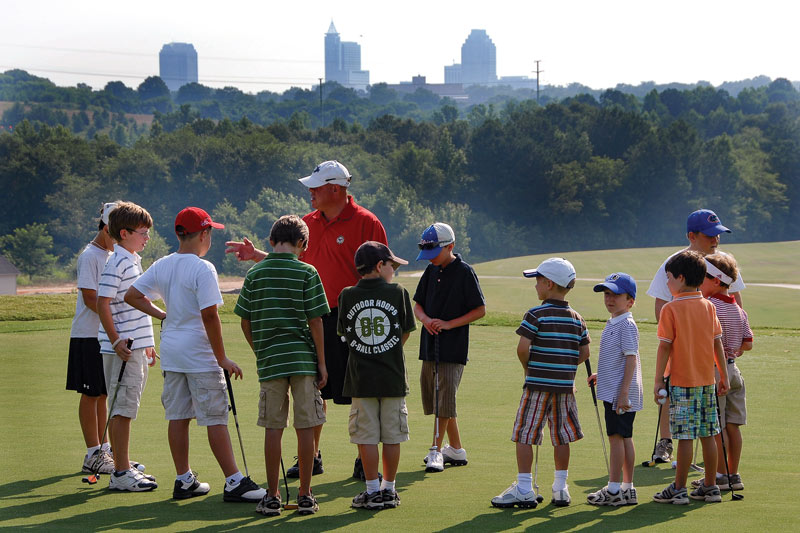
Lonnie Poole Golf Course at North Carolina State University has much to do with development. Brian Green certainly fits in with the theme.
Green (right) is the GCSAA Class A director of golf course maintenance and 23-year association member who oversees Lonnie Poole GC, an 18-hole public facility in Raleigh, N.C. He developed his industry skills there as a student and graduated from the College of Agriculture and Life Sciences with an emphasis in turf management. He left in 1995 but returned in 2012 to oversee the course. Lonnie Poole GC’s goal from the outset when it opened in 2009 was to provide an affordable and accessible place for juniors to develop their skills. Now, that includes college players: Lonnie Poole is home to the North Carolina State University men’s and women’s teams.
“It’s rewarding to see folks being able to utilize the course. It’s certainly nice to be involved in growing the game,” Green says.
Speaking of growth, Green is tested more than some others of his ilk in the region. While numerous courses in the area have switched in recent years from bentgrass to ultradwarf bermudagrass, Lonnie Poole remains in the bentgrass camp. This poses challenges for Green during hot summers. Although the course does have an ultradwarf bermudagrass practice green, the remainder is pure bentgrass.
“We take a number of measures to help manage summer heat stress on our bentgrass greens. A solid hand-watering program is the single biggest factor involved in managing bentgrass greens in the transition zone,” Green says. “Fifteen years ago, and before, we relied on soil probes and visual observations to identify localized dry spots, and we were reacting to conditions instead of staying ahead of things. We had success managing greens with those tools, but the margin for error was much smaller, and you really needed experienced staff to stay on top of things. Ten to 12 years ago, moisture meters really emerged as a tool for managing soil moisture, and they have been a game-changer. By using moisture meters and the data you collect from them, it is much easier to stay ahead of things and identify localized dry spots and areas needing water without overwatering other areas of the greens. Moisture meters have also allowed superintendents to use less-experienced staff to manage soil moisture levels, and that is huge with the labor challenges that our industry is dealing with.”
Editor’s note: Learn how to optimize moisture meter use in What the Tech? Moisture meters for greater efficiency, healthier turf.
Improved fungicides and knowing more about where the fungicides need to be is also a big factor in managing bentgrass in the transition zone. “Fifteen to 20 years ago, we did not water-in many fungicide treatments, less than 25%. Now, based on university research, I am watering-in approximately 60% of my fungicide treatments to get the products into the root zone, where many of the most damaging bentgrass diseases like Pythium root rot and summer patch do their damage,” Green says. “I’m very fortunate that some of my closest friends are some of the most knowledgeable turfgrass scientists in the world who work here at N.C. State. I regularly ask their advice on fungicide or herbicide plans and new products that they are doing research on. They work here on campus and sometimes use the golf course for research. They live in the same town and even the same neighborhood as me. I play golf with them, hunt with them and travel with them to industry events. I am very fortunate to have their close friendships and support.”
Editor’s note: Check out some of the recent turfgrass research out of North Carolina State University, Fungicide fate following mowing and irrigation and Cream leaf blight of ultradwarf bermudagrass.
During a hot summer (usually July through early September), Green alters mowing practices, which includes being less aggressive with mowing heights and cultural practices. “We increase our mowing heights 15% to 20% and will not do any aggressive cultural practices such as verticutting or aggressively dragging in topdressing sand during this time period. Why would you introduce added stress on the bentgrass when they are already dealing with plenty of summer heat stress? We also regularly vent greens during this period to improve soil oxygen and help manage infiltration. We have five fans on problem greens and could use a few more if a power source was closer. We added two fans on our two most challenging greens in 2016, and those greens are now some of our healthiest at the end of the summer,” Green says.
A slew of mentors, including Doug Lowe, CGCS, set an example for how to handle turf. “I’m not sure that the best advice that I received from a mentor concerning bentgrass management is something I was told. I think it was the approach of keeping things simple, consistent, that I learned while working for and with them,” Green says. “The successful mentors that I worked under never made drastic changes to their bentgrass management programs. They knew from experience that they had a solid management program, and they relied on that program and tweaked the program when new products, technologies or improved methods emerged. They constantly talked with other superintendents and university turf faculty members to stay up to date, and they based any changes they made to their management program on what they learned through these conversations. That is still my approach, and it has been successful for me.”
Lowe, who oversees Greensboro (N.C.) Country Club as its golf course maintenance director, had Green as an assistant several years ago at Treyburn Country Club in Durham, N.C. He had an inkling Green would succeed on any surface. Lowe also noted that Green is so highly regarded that Green was not only superintendent but also general manager during his stop at Morehead City (N.C.) Country Club. “He definitely had potential, and he’s taken that potential and done well,” says Lowe, a 35-year GCSAA member. “I played a fundraiser not long ago (at Lonnie Poole), and it was in great shape. He’s made a lot of improvements there.”

In 2020, youth golfers logged nearly 2,000 rounds at Lonnie Poole Golf Course in Raleigh, N.C. The venue also serves NC State’s men’s and women’s golf teams as well as academic and research programs. Photos courtesy of North Carolina State University
Lonnie Poole GC, which is an Arnold Palmer Design Co. product (the design team included North Carolina State graduates Brandon Johnson and Erik Larsen), will be on display April 3-4, when the university’s women’s team hosts the Wolfpack Match Play, followed the next week by the men hosting the Stitch Intercollegiate.
North Carolina State women’s coach Page Marsh has complete confidence in the conditions Green and his staff will present. “He’s great to work with. He really sees himself as part of the team, which I see as super important,” says Marsh, whose Wolfpack finished 10th in the 2014 NCAA Division I championship. “It’s a synergy, being all involved for the student-athlete. You can see the pride in him. I really admire the golf course superintendent, because rarely do they get to be front and center, but they’re the ones that give us the backdrop, the setting, to play our game.”
In a recent one-year span, Lonnie Poole GC hosted more than 1,900 rounds for the Youth on Course program, more than any other location in the Carolinas. Green’s children, Lindsey and Noah, used to play there. This June, Lonnie Poole GC will host a child/father golf school. Undoubtedly, Lonnie Poole GC is living up to its mission. With all the youth and rising collegiate players among the clientele, Green is proud to be part of it — and it’s a way for this 47-year-old to remain young at heart. “It does keep me on my toes,” Green says.
Howard Richman is GCM’s associate editor.